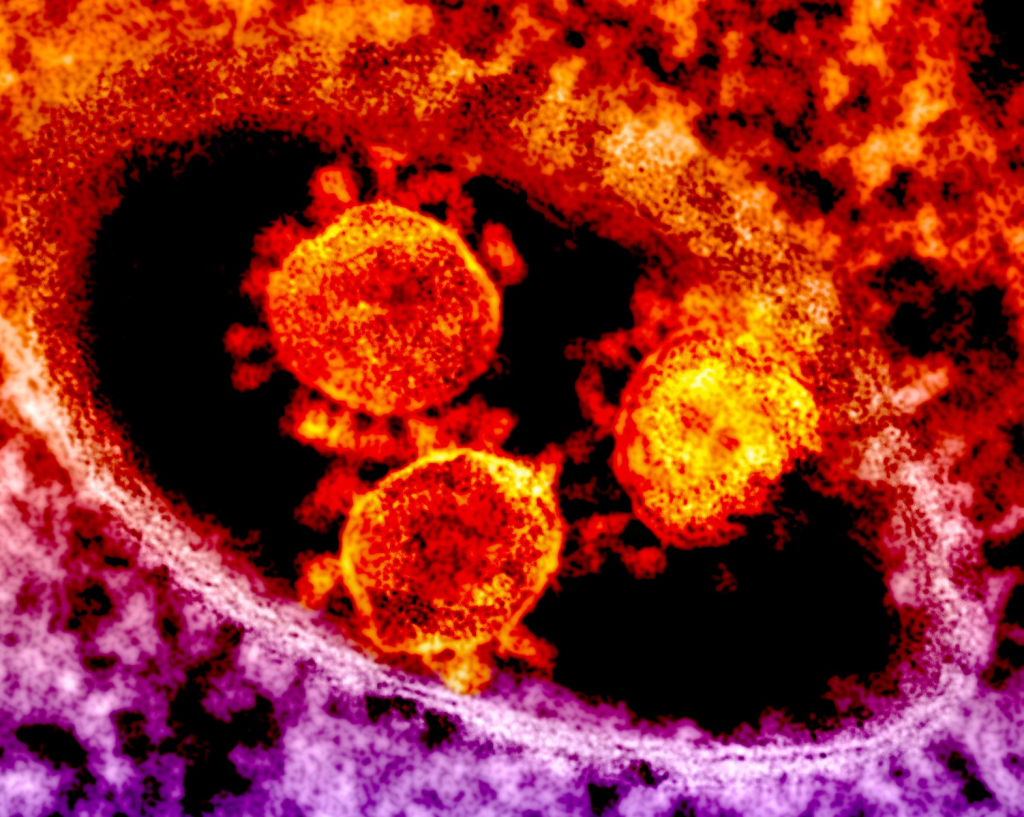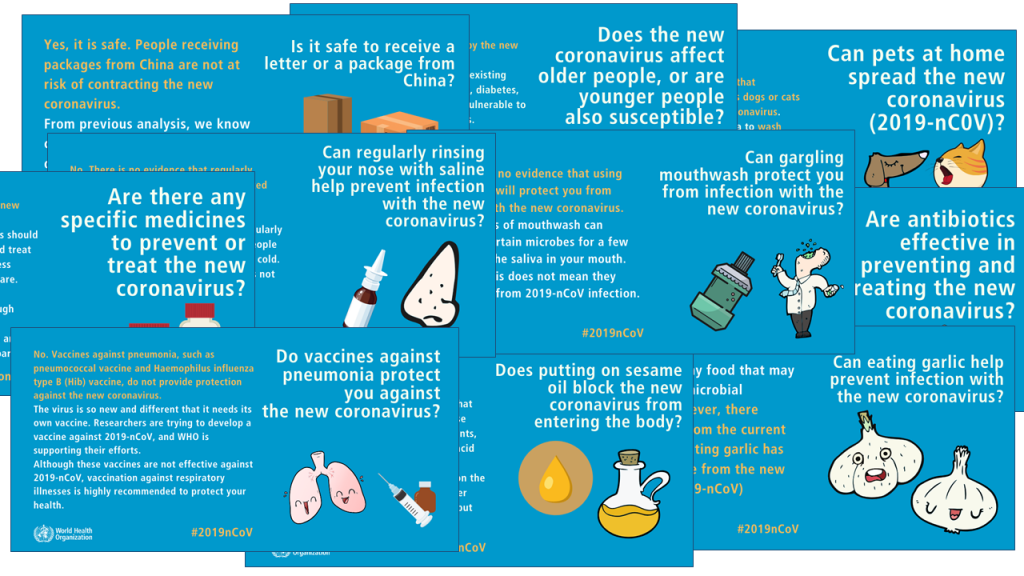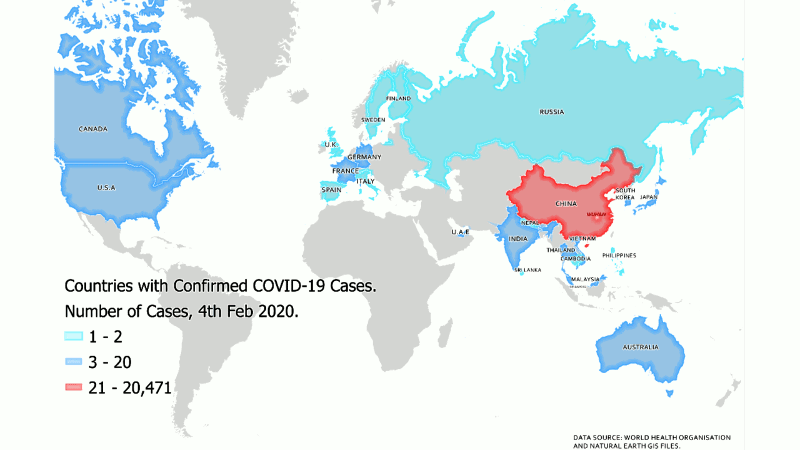This article was edited on 4th March 2020 to include updated information, data and guidance.
The recent international coronavirus outbreak originated in the city of Wuhan, China and has received vast media attention due to its rapid transmission and the number of associated deaths. This blog article aims to provide an overview on what is currently known about the virus, the state of affairs globally and the measures in place for Northern Ireland and the rest of the UK.
Because this is an ongoing and evolving situation, there are many unknowns and new information is emerging daily.
On 11th February, the new coronavirus was designated as SARS-CoV-2 by the Coronavirus Study Group (CSG) of the International Committee on Taxonomy of Viruses, due to its genetic similarity to the virus that caused the SARS outbreak in 2003. Previously the virus was referred to as 2019-nCoV. The World Health Organisation (WHO) also announced the name of the disease resulting from SARS-CoV-2 as COVID-19.
What is a coronavirus?
According to the WHO, coronaviruses are a family of viruses, of which seven (including SARS-CoV-2) are known to infect humans. They cause a range of illnesses from the common cold to the Severe Acute Respiratory Syndrome (SARS) outbreak in 2003 and the Middle East Respiratory Syndrome (MERS) outbreak in 2014. Many coronaviruses are zoonotic, meaning they can be transmitted from animal hosts to humans, potentially leading to the development of novel diseases. Civet cats and dromedary camels were identified as the sources of SARS and MERS respectively.

Coronavirus infections typically cause respiratory symptoms, which can range in severity from coughs, shortness of breath or breathing difficulties to pneumonia or severe acute respiratory distress. These symptoms can also be accompanied by fever, headache, a runny nose or sore throat.
The Centre for Disease Control and Prevention (CDC) states that the most common routes of transmission for coronaviruses are:
- The air, via coughing and sneezing.
- Touching of contaminated surfaces.
- Close contact with an infected individual.
COVID-19
The new coronavirus outbreak began in the city of Wuhan, in the Hubei province of China. Initial reports to the WHO identified 44 cases between 31st December 2019 and 3rd January 2020 for ‘pneumonia of unknown etiology’. Several days later SARS-CoV-2 was isolated and identified as the causative agent, with China then sharing the genetic sequence. The origin of infection is believed to be from the Huanan seafood and live animal market, with subsequent transmission occurring through person-to-person contact. Symptoms range from mild to severe and most commonly present as fever, cough and shortness of breath.
The incubation period of the virus is between 1-14 days, with a standard quarantine period of 14 days being used for individuals with suspected infections. Although there has been some evidence that infected but symptomless individuals may be infectious, the WHO has stated that:
With influenza, people who are infected but not yet sick are major drivers of transmission, which does not appear to be the case for COVID-19.
On 30th January 2020 the WHO announced the COVID-19 outbreak as a Public Health Emergency of International Concern (PHEIC) but has not yet declared the situation as a pandemic, in an effort to avoid “amplifying unnecessary and unjustified fear and stigma, and paralyzing systems”. However, countries are being advised to prepare for further spread of the disease.
On the 28th February 2020 the WHO upgraded the global risk level for COVID-19 to “Very High”, in a bid to encourage countries to increase their preparations. The EU raised their risk level for member states to “moderate to high” on 2nd March, following the increase in COVID-19 cases across Europe.
Prevention and treatment
The WHO has published advice on basic protection measures against COVID-19. They have also released a Myth Busters section, with a series of graphics to combat some of the myths surrounding the outbreak.

As yet, there is no specific antiviral treatment for COVID-19, with care instead focussing on the relief of symptoms. Most mild cases are unlikely to require hospitalisation, but patients are advised to contact relevant public health authorities and self-isolate to prevent passing on the virus to others. For more severe cases, the WHO has advised a range of treatments, depending on the disease presentation and has compiled an online course (on detection, prevention, response and control).
As yet there is no vaccine, but recently the UK Government donated £20 million to the Coalition for Epidemic Preparedness Innovations (CEPI) – a global alliance that finances and coordinates the development of vaccines for emerging infectious diseases. Several small pharmaceutical companies have already announced development of experimental vaccines for COVID-19, with a reported ‘aspirational’ timeline of 12–18 months before such a vaccine could be deemed safe and effective.
Current known epidemiology
As of 3rd March 2020, over 88% of confirmed COVID-19 cases have arisen in China. The disease has been detected in a further 72 countries worldwide, and has caused deaths in 10 of these countries. So far, there have been 85 confirmed cases of COVID-19 in the UK and no associated deaths. These numbers are likely to change daily and more up-to-date information from the WHO can be found here.
This graphic illustrates the global spread of the virus from 4th February – 3rd March 2020:

Data source: WHO; Numbers for Japan include those diagnosed on a cruise ship in Japanese territorial waters.
The current estimated case-fatality rate (CFR) for COVID-19 in China is around 2.3%, which is lower than was seen for the SARS or MERs outbreaks (10% and 34% respectively). Although less deadly, COVID-19 appears to be more contagious, with more reported cases than both SARS (8,098 cases with 774 deaths) and MERS (2,494 cases and 858 deaths) put together.
According to China’s National Health Commission most cases of COVID-19 in China occurred in people aged 30-79 years old, but the CFR increased significantly for those aged 70+. In contrast, children appear to be least susceptible to developing severe disease from the virus. Patients with co-morbidities such as cardiovascular disease, diabetes and chronic respiratory diseases are also more at risk of dying from COVID-19. This article by the BBC goes into further detail.
On 26th February 2020, the WHO reported that, for the first time, there were more new cases reported globally outside of China and that, for China, the epidemic was in decline after peaking between 23rd January and 2nd February 2020.
How has the world reacted to the outbreak?
On 23rd January 2020 China declared a lockdown of Wuhan, with public transport suspended, many businesses closed and people instructed to stay indoors. Additional cities in the Hubei province have also initiated similar quarantines and 50-60 million people are estimated to be living under these conditions with no end date declared. China also introduced port-of-exit screenings for individuals and further restrictions were imposed across the rest of mainland China.

Counter to WHO recommendations, at least 72 countries have initiated travel restrictions of varying degrees, and other measures such as quarantines, school closures, cancelling or postponing events and businesses encouraging employees to work from home are also being implemented. In the UK, some airlines suspended flights to and from mainland China.
Several countries, including the UK, have evacuated their own nationals from the city of Wuhan and from a cruise ship in Japan that had experienced an outbreak of COVID-19, with a subsequent two week mandatory quarantine.
Northern Italy, where there has been a sharp rise in the number of COVID-19 cases since 23rd February 2020, has initiated lockdowns in 11 towns at the centre of the outbreak.
Several countries have decided to temporarily close their borders to neighbouring Iran after it also experienced a recent surge in COVID-19 cases.
COVID-19 and the UK
Cases and tests
To date of publication there have been 85 confirmed cases of COVID-19 in the UK. Five of the recent cases were contracted within the UK and it is not yet clear how they caught the virus.
On 10th February 2020, the Health Secretary, Matt Hancock, announced that Health Protection (Coronavirus) Regulations 2020 had been put in place with ‘immediate effect’, giving greater powers to police to enforce quarantines. Both Scotland and Northern Ireland have recently made COVID-19 a notifiable disease.
Hospitals and other health centres have set up priority assessment pods for suspected coronavirus infections. Public Health England announced that more widespread testing for COVID-19 will take place with 100 GPs and eight hospitals testing for those who present with flu-like symptoms. The NHS across the UK and the HSC in NI are currently rolling out drive-through testing services for those suspected of being infected. Further testing of patients in intensive care with breathing difficulties will also be implemented, in an attempt to curb hospital-acquired transmission.
Official guidance and advice
Following on from the WHO declaration of the COVID-19 outbreak as a PHEIC, the UK Chief Medical Officers increased the risk to the public from low to moderate, although the risk to individuals in the UK remains low. The most up-to-date information and guidance for the UK public is found here.
Currently the Foreign and Commonwealth Office advise against all travel to the Hubei region and to avoid all other non-essential travel to the rest of mainland China and parts of South Korea and northern Italy.
A government campaign was launched in early February 2020, providing information on COVID-19 to the UK public.
The UK Government has published guidance for educational institutions in relation to COVID-19. Although Public Health England does not currently advise the closing of schools, some were shut across the UK, over fears of pupils and staff contracting COVID-19, after school trips returned from Northern Italy.
The NHS has published a ‘Common questions‘ webpage about the coronavirus, to provide the public with the correct information and advice.
A further public health campaign is expected to be launched by the UK Government imminently.
How prepared is the UK?
Currently, the UK is in “Containment” phase and is working to quickly identify cases, isolate them and trace any contacts. So far this strategy appears to be working, as there has been no sustained transmission events within the UK.
If containment ultimately fails, contingency plans are now in place. The UK Government published its Coronovirus Action Plan on 3rd March, outlining what steps will be taken in response to a range of scenarios, with most of the more extensive ones coming at the “Delay” and “Mitigate” stages of the plan.
The NHS also has plans in place to cope with the disease, and NHS England has recently announced the COVID-19 outbreak a “level four incident” (the highest emergency level). However, questions have been raised about the availability of critical care beds and Extra Corporeal Membrane Oxygenation (ECMO) – a treatment used for the most severely ill patients to support lung function. ECMO is available for adults and children in a number of centres in England and Scotland, which also provide the service to Wales and Northern Ireland.
Northern Ireland
As of 3rd March 2020, there has been one case of COVID-19 in Northern Ireland, although further cases are anticipated.
The Northern Ireland Department of Health has stated that they are following the situation and liaising with partners across the rest of the UK and the Republic of Ireland (RoI).
The NI Chief Medical Officer, Dr Michael McBride, has issued advice to health care workers on what to do in the event of a suspected coronavirus infection and has confirmed that measures are in place to isolate and treat any such cases.
On 28th February, the Department of Health announced that NHS 111 coronavirus service has been extended to Northern Ireland. COVID-19 also became a notifiable disease on 29th February.
In an oral statement to the NI Assembly on 2nd March, the Minister of Health, Robin Swann, assured that there are ‘robust infection control measures in place’ to deal with the outbreak.
The First Minister, Arlene Foster, has announced COVID-19 as a “top priority” and The Executive Office has now established a civil contingencies operation room.
Up-to-date information for Northern Ireland can be found here. Advice for educational settings has also been issued.
Republic of Ireland
As of 3rd March 2020, there have been two cases of COVID-19 in the Republic of Ireland.
Advice for RoI is largely similar to that for Northern Ireland, with all non-essential travel to China discouraged. RoI is not imposing any entry restrictions, nor employing entry screening measures currently. Dr Tony Holohan, RoI’s Chief Medical Officer, stated that “procedures have been in place to deal with [COVID-19] for a number of months”. Further details of RoI’s response can be found here.
Conclusions
The media coverage and response to COVID-19 is understandable. However, it is important to put this outbreak into perspective. Seasonal flu, for instance, may have a mortality rate well below 1%, but is still a major global healthcare burden due to the millions of people who catch it yearly and the hundreds of thousands of associated deaths. One study, for example, estimated that between 1999 and 2010, in the UK alone, 7,000 to 25,000 people died each season from influenza.
The key concern with COVID-19 is that it is a newly emerged disease that, although with a lower fatality rate than seen for SARS and MERS, is exhibiting greater transmissibility. It is also more serious for older individuals and those with pre-existing health issues. Unlike flu, there is also no vaccine yet available to help protect those who are more vulnerable. There are also question marks over how well prepared the UK is, if COVID-19 becomes a widespread outbreak.
As yet, it is unclear how the situation will unfold world-wide, although the window for containing the outbreak is arguably narrowing, as more and more countries report cases. A recent Nature article notes that estimates on when the outbreak will peak vary drastically. For example, some experts predict several million infections before the outbreak begins to decline sometime between late March and May 2020. Another model, from the University of Toronto, predicts up to 300,000 cases by mid-March 2020.
According to a news article from the Business Insider, experts have suggested three possible outcomes of the COVID-19 outbreak:
- The virus will remain in circulation, but become more seasonal (like flu) or present as a milder infection.
- Public health interventions eventually lead to a containment of the outbreak (similar to SARS).
- Development of a vaccine.
However, much is still not yet known about COVID-19 and these estimates and outcomes may change as more information comes to light.
Currently, risk to individuals in the UK remains low and the best approach is to follow the advice to undertake good hygiene practices and to self-isolate and inform the relevant health professionals if exhibiting symptoms.
Please note that the information provided here was updated on 4th March 2020 but, as the situation is potentially fast-moving, it is unlikely that we will be able to keep this page up-to-date.

